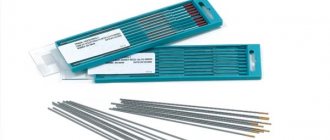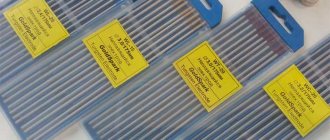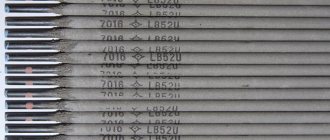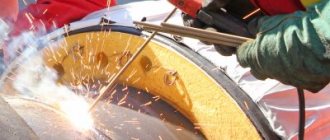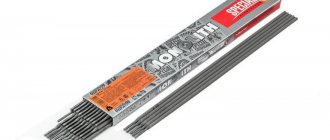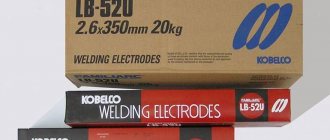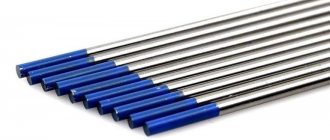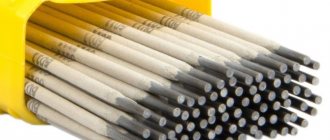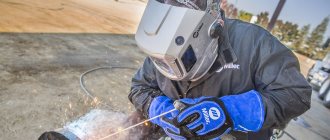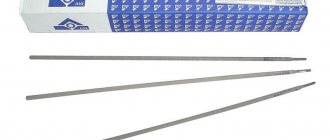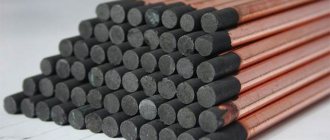Protect your eyes | 05/25/2016
Argon welding is a modern welding using a non-consumable tungsten electrode in an inert gas environment. Such welding protects the metal from interaction with an oxygen environment, which causes its oxidation and nitriding. The inert gas argon is most often used as protection during operation, but it is possible to use nitrogen, helium and various gas mixtures. In TIG welding, Ar (argon) is widely used, but He (helium) is used in rare cases to solve certain production problems.
Gas components are constantly used in this welding. Indeed, argon does not form an explosive mixture with the atmosphere. It is slightly heavier than air and more practical for welding than helium. But the arc itself, when using helium, has 1.5–2 times more energy than when using the same argon. A mixture with the following components is widely used during welding: 35–40% pure argon plus 60–65% pure helium. Argon completely stabilizes the arc, and helium efficiently fuses the metal.
Tig welding has only two international names. TIG – welding with non-consumable special tungsten electrodes in an inert gas environment. MIG/MAG - welding with the electrode wire itself directly in an environment of inert argon or even carbon dioxide.
WORKING WITH TUNGSTEN ELECTRODES
The use of any type of tungsten electrode can be extremely effective, but only with the right approach. The correct selection of products, as well as setting the necessary welding parameters, will allow you to complete the work efficiently and quickly, without encountering any difficulties.
First of all, it is worth paying great attention to the choice of the thickness of the tungsten electrode. You can familiarize yourself with the main recommendations for selecting the optimal diameter in the table
An equally important parameter that influences the final result of the work is the supplied current. A detailed table of currents and electrodes is presented below.
It is important for all craftsmen using accessories of this type to know that with the correct selection of the accessories themselves and welding modes, the surface of the product should shine. If this is not the case, and it is matte, you should think about the current load
Perhaps it has exceeded all possible acceptable parameters too much. The presence of a colored deposit on the electrode after completion of work only indicates that too little gas is being supplied or it is worth increasing the purge time. It is very simple to prevent the appearance of growths on the end of the product, or so-called crowns. It is enough to improve the quality of the gas environment and increase the level of electrode cooling.
Electrode marking
In the vast majority of cases, using a consumable electrode in an argon environment is impractical. It is much more correct to use a tungsten non-consumable tool. Of course, tungsten also melts. But at actual temperatures of the welding process it is completely stable. In addition to pure metal, you can use its mixture with lanthanum and calibrated tungsten.
The practical designation of electrodes for argon welding, for reasons of convenience and safety, is done by coloring. Green tool or WP is widely used. This designation is given to a product made of technically pure tungsten. Using such devices, you can cook magnesium, aluminum, and their alloys with each other and with other metals.
Please note: this standard applies not only to tools for argon arc welding, but also to other products for similar work. Returning to the WP series products, it should be emphasized that they only operate on alternating current. Application on direct current is hampered by the impossibility of normal sharpening. Continuing the review of types of argon-arc electrodes, it is worth moving on to the WZ option. It implies a white color. Such instruments contain a noticeable amount of zirconium oxide.
The arc of WZ electrodes is very stable. A similar device is used when you need to cook:
- aluminum;
- bronze;
- nickel and alloys of these metals.
WT electrodes are marked with red paint. They use thorium oxide as an additional element. This option is used very often, but you must understand that it is radioactive. We have to use maximum protective measures. Work only in places with reliable, strong ventilation. The red welding tool is used to work with:
- tantalum;
- stainless steel;
- molybdenum
The dark blue electrode (WY) also needs to be distinguished by color. This solution is useful for particularly critical or very complex connections. Such tools are useful in working with steel of varying degrees of carbon content and alloying. WY finds application in the manipulation of titanium and various grades of stainless steel.
Tungsten electrode PTK WL-20
Tungsten electrodes WC-10 (pink) and WC-20 (gray)
WC-10 is a cerium oxide (CeO₂) electrode, pink color code. The mass fraction of cerium oxide reaches up to 1%.
WC-20 is an electrode containing cerium oxide (CeO₂), the mass fraction of which varies from 1.8 to 2.2%. Has a gray color code.
- Features: Cerium as an alloying element improves arc stability and ease of starting while reducing burnout. Tungsten grade WC-10/20 is recommended for use in short welding cycles at low current values.
- Current type: Cerium electrodes are designed for welding with direct and alternating current (AC/DC).
- Metal: Electrodes are designed for welding aluminum, all types of steels and their alloys, especially thin sheets.
Only branded tungsten electrodes PTK WC-20 with a diameter of 1.6 to 3.2 mm are on sale.
Tungsten electrode WY-20 (blue)
This is a tungsten electrode containing yttrium oxide (Y₂O₃), which is color coded blue. The mass fraction of the alloying additive varies from 1.8 to 2.2%.
- Features: Yttrium tungsten electrodes can withstand high currents and, subject to welding technology, provide a high-quality and reliable seam, therefore they are especially suitable for welding particularly critical structures.
- Current type: Designed for direct current (DC) welding only.
- Metal: This type of electrode is suitable for welding all types of steels, titanium, copper and their alloys.
The range of WY-20 electrodes is presented in diameters of 1.6 / 2.0 / 2.4 and 3.2 mm.
Tungsten electrodes WZ-3 (brown) and WZ-8 (white)
WZ-3 is a zirconium oxide (ZrO₂) electrode, color code brown. The mass fraction of cerium oxide reaches up to 0.3%.
WZ-8 is an electrode containing zirconium oxide (ZrO₂), the mass fraction of which varies from 0.7 to 0.9%. Has a white color code.
- Features: This type of electrodes can be used when welding at high currents. They have poor arc stability and are very demanding on the cleanliness of the weld pool. It is recommended to sharpen the working end of these electrodes in the shape of a hemisphere.
- Current type: Designed for welding on alternating current (AC) only.
- Metal: Electrodes are designed for welding aluminum, magnesium, nickel, bronze and their alloys.
Only branded tungsten electrodes PTK WZ-8 with diameters of 1.6 / 2.0 / 2.4 and 3.2 mm are on sale.
Tungsten electrodes WT
WT brand electrodes are doped with thorium oxide (ThO₂) and include the following varieties:
- WT-10 - yellow color code, thorium dioxide content up to 1%;
- WT-20 - red color code, thorium dioxide content up to 2%;
- WT-30 - purple color code, thorium dioxide content up to 3%;
- WT-40 - orange color code, thorium dioxide content up to 4%.
Tungsten electrodes made of thorium oxide alloy are used in direct current (DC) welding of stainless steel, copper, nickel, titanium and their alloys.
An important and distinctive feature of thorium is its radioactivity. Thorium is considered a radioactive metal, making inhalation of fumes and dust a health risk to the welder and disposal an environmental risk. Based on these considerations, there are no WT thorium tungsten electrodes in the range of PTK branded products.
Types of tungsten electrodes
Models of tungsten electrodes differ in color:
Green (WP) - this model has the highest content of pure metal, since the proportion of impurities is only 0.5%. When using alternating current they provide excellent arc stability. Balance can be improved with high frequency stabilization by the oscillator. The properties manifest themselves best with sinusoidal alternating current. Tungsten electrodes are used for welding aluminum, as well as its alloys, and magnesium. Due to the limited thermal load, in these varieties the end of the tool is made in the form of a ball.
Tungsten electrodes type WP
White (WZ8) – this model additionally contains zirconium oxide. Here, under no circumstances should there be any contamination in the weld pool. Use on alternating current is preferred. This variety provides increased stability of the arc. The current load is higher than that thorium, lanthanum and cerium electrodes can withstand. The sharpening of tungsten electrodes here is made in the form of a sphere. Used for welding nickel, magnesium, bronze, aluminum, as well as alloys of these metals.
Tungsten electrodes WZ8
Red (WT20) – this model contains thorium oxide. Red ones are one of the most common, as they were able to perform best when welding with direct current, significantly superior to models without additives. Thorium itself is a low-level radioactive metal, so it has a negative impact not only on the environment, but also on the health of the artist. Discharge when used periodically does not pose a great risk to health, but constant use can cause complications. A tungsten electrode for argon welding with thorium performs well on both direct and alternating current. It is possible to change the sharpening angle of the tip, since even with high current strength they do not melt in their thin places. Standard sharpening is done in the form of a platform with protrusions. Can be suitable for welding chalk, nickel, titanium, tantalum, molybdenum and silicon bronze.
Tungsten electrodes WT20
Dark blue (WY20) is a titrated model that has increased resistance to high temperatures. They are used with direct current with straight polarity. Serves as a tool for welding particularly critical structures. The oxide additive here is about 2%. Thanks to yttriation, the stability of the cathode spot increases, therefore, even when the current changes over a wide range, the arc remains stable. Tungsten electrodes are used for welding stainless steels, low-alloy and carbon metals.
Tungsten electrodes WY20
Gray (WC20) – this model contains about 2% cerium oxide. Cerium is a very common rare earth non-radioactive metal. It has a positive effect on the emission of the electrode. This makes initial starting easier and the current operating range wider. These are universal tools that can be used with any type of electricity. Here, high arc stability is noticeable even at low current. They are used for orbital welding of pipelines and thin sheets of metal. At high temperatures, cerium concentrates in the tip, which becomes a disadvantage. They are used to work with neobium, tantalum, molybdenum, bronze, and silicon bronze.
Tungsten electrodes WC20
Gold and blue (WL15 and WL20) - both brands contain lanthanum oxide. This gives good indicators for the initial start of the arc. With them, the likelihood of burning through the metal is much lower. The arc remains stable throughout the entire period of operation. The difference between the brands is that the gold ones contain 1.5% additives, and the blue ones - 2%. The more lanthanum oxide in the composition, the higher the operating current range. Here it is 1.5 times more than in other brands. This affects the wear on the tip surface, which is considered one of the thinnest in the industry. It is used to weld high-alloy steels, copper, aluminum and bronze.
Tungsten electrodes WL-15
Properties of filler metals and their influence on the quality of the weld
Tungsten Electrode WP (Green)
Pure tungsten electrodes are classified as WP and have a green color code. The tungsten content in them is at least 99.5%.
- Features: Electrodes marked WP provide high arc stability, but have poor heat resistance and electronic emission. Due to this limited thermal load, the working end of the electrode must be sharpened into a round shape (ball).
- Current type: Designed for welding with sinusoidal current (AC) in argon or helium.
- Metal: This type of electrode is designed for welding aluminum, magnesium, nickel and their alloys.
Due to the fact that WP electrodes were used on transformer equipment, and now most welding equipment is inverter, the need for such electrodes has decreased significantly, so these electrodes are not in the PTK range.
Tungsten electrodes WL-10 (black), WL-15 (gold) and WL-20 (blue)
WL-10 is a lanthanum oxide (La₂O₃) electrode, color code black. The mass fraction of lanthanum oxide reaches up to 1%.
WL-15 is a lanthanum oxide (La₂O₃) electrode, gold color code. The mass fraction of lanthanum oxide varies from 1.4 to 1.6%.
WL-20 is an electrode containing lanthanum oxide (La₂O₃), the mass fraction of which reaches up to 2.2%. The electrode color code is blue.
- Features: These are universal electrodes that can withstand high current loads, improve arc stability and ease of starting while reducing burnout. Lanthanum electrodes are less likely to contaminate the seam with tungsten, which is especially important during finishing work. They also retain the sharpness of the working end for a long time.
- Current type: Electrodes can be used for direct and alternating current (AC/DC) welding.
- Metal: Used for welding carbon and alloy steels, aluminum, titanium, nickel, copper and magnesium alloys.
The range of PTK branded products includes tungsten electrodes WL-15 with a diameter from 1.6 to 4.0 mm and WL-20 with a diameter from 1.0 to 4.0 mm.
Is it possible to change the size
The size of a tungsten, titanium or thistene ring cannot be reduced or increased. The equipment of traditional jewelry workshops is not designed to process such hard metals.
We attribute a similar property to 316L steel. If you don’t believe me, try to find a craftsman who will resize the steel ring. And if you find a specialist with the appropriate equipment, the cost of the service is unlikely to please you. The price tag will be comparable to resizing a gold ring and will likely exceed the original cost of your ring.
| Tungsten rings | Titanium rings | Tisten rings | 316L steel rings |
| Can't resize |
A profitable alternative when buying rings online is to choose a store that provides a free exchange service. The opportunity to exchange a ring of the wrong size by mail or when visiting a showroom in our store is available within 30 days after receiving the order. To reduce the likelihood of making an erroneous choice, we recommend that you familiarize yourself with methods for determining ring size at home before purchasing online.
Which brands are the best?
Tungsten electrodes are presented by both foreign and domestic manufacturers.
The most popular were:
- products of the Swedish company ESAB, manufactured not only in Europe, but also at Russian factories;
- the high price of Fubag rods from Germany corresponds to their quality;
- the entire range of tungsten electrodes is in the catalog of the Italian brand BlueWeld;
- lanthanum wire EVL from Ecotek plant.
In addition to products from large factories, trading enterprises offer products from many Chinese manufacturers. The most popular were Shaanxi Yuheng Tungsten Molybdenum Industrial Co., Ltd, which has been producing tungsten electrodes for over 15 years, Hangzhou Linan Dayang Welding Material Co., Ltd, etc.
Working principle of argon arc welding
In international designation, the argon arc method has the abbreviation TIG. It is actively used in production and workshops. It is used to connect cracked car parts (crankcase pans, engine cooling blocks), assemble containers for the food and chemical industries, make stainless heated towel rails, manifolds, liquid filters, etc. In a garage, such a device can successfully perform body repairs or produce small parts. products.
The operating principle of argon welding is to join metals with an electric arc in an inert gas environment. The process requires a current source that lowers the voltage and increases the amperage. The current is supplied to a torch equipped with a tungsten electrode. It is non-consumable, so it is easier for the welder to control the length of the arc, which should be 2-5 mm. The ground cable is connected to the product.
Touching the tip of a tungsten needle to the part initiates an electric arc. For thin seams, transverse vibrations are not required - the electrode is moved evenly, from right to left along the seam line, the joint surface is smooth as a mirror. If there is a gap between the parts or it is necessary to expand the boundaries of the seam, then when moving the torch, the welder makes slight oscillations on the sides, stretching the weld pool. This promotes the formation of small scales.
Tig welding process.
The arc temperature ranges from 2000 to 5000 degrees, depending on the current strength. This allows the edges of the metal to be melted and joined with a thin seam. To strengthen the structure, filler wire is used, fed with the welder’s second hand into the weld pool. Thus, you can increase the height of the bead, give the seam a scaly appearance, and even perform metal surfacing for subsequent mechanical processing (turning on a lathe, grinding).
To protect the weld pool from the external environment, the inert gas argon is used. It is supplied from the cylinder to the burner and displaces normal air. This eliminates the formation of pores in the seam structure. The connection is tight and durable. At the same time, the shielding gas cools the tungsten electrode and ceramic nozzle so that they do not overheat. At the final stage, when the arc is extinguished, argon helps to solidify the seam.
Scheme of the argon arc welding process.
Pros and cons of the TIG method
The TIG method has clear advantages over other welding methods, but working with an argon welding machine also has several disadvantages that you need to be prepared for when choosing this welding method.
Pros of the TIG method
- local heating eliminates serious deformation of the product;
- a thin tungsten needle allows you to create narrow, neat seams;
- You can weld with or without an additive, affecting the height of the bead;
- the connection is obtained without a slag crust on top;
- in most cases no follow-up is required
- mechanical processing; can weld stainless steels and non-ferrous metals;
- the seams are sealed and can withstand high pressure;
- there are no metal splashes sticking to the surface.
Disadvantages of the TIG method
- connection speed is inferior to MIG;
- the burner cap interferes with work in hard-to-reach places;
- the ceramic nozzle slightly limits the visibility of the weld pool;
- the quality of the seam depends on the user’s skills (you won’t be able to immediately take it and cook it like a semi-automatic machine);
- it is necessary to constantly feed the additive with the second hand and control its length (when welding, the length of the wire quickly shortens, and long pieces are inconvenient to hold in your hands,
- because they are “walking”);
- tungsten electrodes are more expensive than coated ones;
- additional costs for argon;
- It is impossible to qualitatively weld parts outdoors in strong winds (argon is blown away and the weld pool remains unprotected).
Cost of electrodes
The price of stainless steel electrodes is determined by several factors, among which one of the main ones is the manufacturer. Among the types of consumables offered, the most affordable prices are electrodes designed for joining workpieces made of steel with low carbon content.
Among the products of foreign manufacturers, this requirement is met by electrodes of such brands as WT, ESAB, E3, WL. On the domestic market you can also find many worthy products that are not only more affordable, but also have all the characteristics of foreign electrodes - EHF, EVL, EVI , EVT.
Many different products and designs are made from stainless steel, although the process is quite complex. This is largely due to the low weldability of this metal. To ensure that this nuance manifests itself as little as possible not only during welding work, but also during the operation of the products, it is necessary to use electrodes suitable for this metal.
Each type of electrode that can be purchased on the market today is designed for welding a specific type of product , which must be taken into account when choosing this consumable. Professional welders are well aware of what electrode markings mean, but amateurs may have problems with this. Therefore, experts advise to study very carefully before purchasing all the characteristics of electrodes of a particular brand, so as not to later regret the low quality of the welding work performed.
Read also: How to check the winding of an angle grinder with a multimeter
Argon welding is a modern welding using a non-consumable tungsten electrode in an inert gas environment. Such welding protects the metal from interaction with an oxygen environment, which causes its oxidation and nitriding. The inert gas argon is most often used as protection during operation, but it is possible to use nitrogen, helium and various gas mixtures. In TIG welding, Ar (argon) is widely used, but He (helium) is used in rare cases to solve certain production problems.
Tig welding has only two international names. TIG – welding with non-consumable special tungsten electrodes in an inert gas environment. MIG/MAG - welding with the electrode wire itself directly in an environment of inert argon or even carbon dioxide.
Color change over time
If the ring begins to darken or show signs of rust, it is a piece of mediocre quality jewelry. Rings made of tungsten, titanium, thisten and stainless steel (without color coating) do not change the original shade, are not afraid of exposure to ultraviolet radiation, water (even sea water), are resistant to corrosion, and do not oxidize when interacting with the skin (unlike some silver jewelry) .
| Tungsten ring | Titanium ring | Thisten ring | 316L steel ring |
| Do not change color, do not darken, do not fade, do not rust. |
A change in the color of the tungsten ring, as well as models made of thisten or titanium, is a sign of an increased content of impurities in the metal alloy. As well as the darkening of the steel ring - the fact that its composition does not correspond to the proven grade of 316L steel.
Physico-chemical composition
Most tungsten electrodes for overhead lines contain 97% tungsten and higher. Naturally, this parameter is individual for each brand, but in most cases it is pure metal. Tungsten electrodes for argon arc welding, which without additional elements contain 99.5% tungsten. In other cases, on average, it contains 1.5-3% of such additives as:
- Cerium oxide;
- Lanthanum oxide;
- Zirconium oxide;
- Thorium oxide.
Symbols and markings
Marking tungsten electrodes is quite simple, since their composition does not contain a lot of different elements, but there is only 1 additive, or there is none at all. The colors of the tungsten electrodes precisely correspond to the various additives. If you look at the designation, then the typical one here will be, for example, WL15, which will be deciphered as:
- W – tungsten electrode;
- L – presence of lanthanum oxide;
- 15 – presence of additive (in this case lanthanum oxide) 1.5%.
Thus, the second letter denotes the additive, and the numbers indicate its content in hundredths of a percent.
Selecting a tungsten electrode
The choice is made based on the conditions of use. If welding is carried out using alternating current, then it is better to choose purely tungsten ones. Zirconium additives increase arc stability and maximum operating temperature. The thorium oxide in the composition improves temperature resistance, so such electrodes can be given any shape. Yttriated tungsten tools provide better arc stabilization. Cerium in the composition ensures versatility of use in any mode.
Basic modes and nuances of application
The main feature of using these tools is the selection of the correct current mode, regarding its type and polarity, since the characteristics of the electrodes manifest themselves differently in each case.
| Diameter size, mm | Constant current, straight polarity, A | Constant current, reverse polarity, A | AC current, A |
| 1 | 15…60 | 15…20 | |
| 1,6-2 | 20…100 | 20…60 | |
| 3 | 80…250 | 25….40 | 60…150 |
| 4 | 200…360 | 40…50 | 120…200 |
| 5 | 350…550 | 50…80 | 180…300 |
| 6 | 500…700 | 80…125 | 250…340 |
Manufacturers
Due to their popularity, such electrodes are produced all over the world. The following brands can be found on the market:
- Tungstone (Poland);
- Abicor Binzel (Germany);
- Jasic (China).
Argon TIG welding
Benefits Selecting and sharpening tungsten electrodes Performing TIG welding Errors in TIG welding
TIG welding
The abbreviation TIG stands for Tungsten (tungsten) Inert (inert) Gas (gas). That is, TIG welding means welding with tungsten electrodes in an inert gas environment. In this case, the metal (in the form of a rod) to fill the seam (if necessary) is fed with the second hand. Argon is most often used as an inert gas; it protects the metal, heated by the arc to a high temperature, from air gases - oxygen, nitrogen, water vapor. Inert gas is continuously supplied to the arc combustion zone. It looks like this:
TIG welding
TIG welding torch design
Helium is used less frequently due to its high cost and higher consumption (due to lower density). However, at the same current value, an arc in helium releases 1.5-2 times more energy than in argon. This promotes deeper penetration of the metal and significantly increases the welding speed. Therefore, when welding refractory metals, helium is preferred. A mixture of argon and helium (the optimal composition contains 35-40% argon and 60-65% helium) has the advantages of both gases: argon ensures arc stability, helium provides a high degree of penetration.
Advantages
- TIG welding produces a clean, neat and precise weld.
- TIG welding can weld more metals than any other welding method. Corrosion-resistant steel, aluminum, magnesium, copper, bronze, etc. are welded with high quality.
- TIG welding allows you to better control the weld pool and the entire process, which allows you to make neat and precise seams. There are no sparks or splashes during the welding process (if everything is done correctly), because filler metal is supplied without excess. There is no slag on the seam, and the air does not smoke, as when welding with coated electrodes.
Selection and sharpening of tungsten electrodes
Tungsten electrodes come in different sizes and compositions.
Tungsten electrodes
As the name implies, tungsten electrodes are made from tungsten, of which they contain 97-99.5%. In this case, depending on the conditions of use, various additives are used. Tungsten has a very high melting point (3380°C), the highest of the metals. Therefore, electrodes made from it are able to withstand the high arc temperature relatively successfully.
| Tungsten electrode type, composition, marking | Characteristic |
| Tungsten electrodes without special additives Tungsten at least 99.5%, the rest impurities WP (green) | Pure tungsten has a very high energy required for an electron to leave the atom, making it more difficult to strike an arc than with doped electrodes. In addition, due to the high electron output energy, the temperature at the tip is higher, resulting in a short electrode life. These electrodes are only used for AC welding, but it is best not to use them at all. |
| Tungsten electrodes doped with thorium oxide 1.8-2.2% ThO2 WT-20* (red) | For a long time, thoriated electrodes were the most commonly used and have therefore become the standard used to compare other tungsten electrodes. However, since thorium is radioactive, many users switched to other alternatives (when they became available). Thorium is not harmful to health when it is in the electrode, but the dust generated during sharpening is dangerous, which can get into the lungs or open wounds. Thorium is also released into the air during welding, but in much smaller quantities. Therefore, precautions should be taken when sharpening and welding. Despite these problems, thoriated electrodes are still often used. They have a low electron output energy, and most importantly, they work well under current overload. These electrodes are used for direct current welding and should not be used with alternating current. |
| Tungsten electrodes doped with cerium oxide 1.8-2.2% CeO2 WC-20* (gray) | These electrodes are especially good for low amperage DC welding because they start the arc very easily and generally cannot operate at the same high currents as thoriated electrodes. Good for short welding cycles. In particular, they are widely used for welding very small parts. Used for direct current welding and should not be used with alternating current. |
| Tungsten electrodes doped with lanthanum oxide 1.8-2.2 La2O3 WL-20* (blue) | They have low electron output energy and the lowest tip temperature for longer service life. If you do not overload the electrode with current, it can last longer than a thoriated electrode. But it cannot operate at the same high currents as a thoriated electrode. Used for DC welding and will also perform well with AC. |
| Tungsten electrodes doped with zirconium oxide 0.7-0.9% ZrO2 WZ-8 (white) | This material is the most commonly used in AC welding because it has a more stable arc than pure tungsten. They prevent contamination of the bath well during alternating current. Under no circumstances are they recommended for DC welding. |
| Tungsten electrodes doped with yttrium oxide 1.8-2.2% Y2O3 WY-20* (dark blue) | They withstand high currents without contaminating the weld metal with tungsten. Used for welding particularly critical connections with direct current. |
| Other options | There are other, less common electrodes, for example with a mixture of different oxides. |
* - the number in the marking indicates the concentration of the oxide, and there are electrodes with lower concentrations, for example WL-15 (golden), containing about 1.5% lanthanum oxide. They also have a different color code.
Even if two electrodes are of the same type and have the same dopant concentration, but are manufactured by different companies, they may differ noticeably in performance. The grain size, structure and distribution of the oxide are of great importance. Therefore, choose the manufacturer more carefully.
Selecting the electrode diameter:
| Metal | Metal thickness, mm | Electrode diameter, mm |
| Non-ferrous metals | 1 | 1,6 |
| 2 | 2 | |
| 4 | 3 | |
| 5-6 | 4 | |
| 7 or more | 5 | |
| Carbon, structural and stainless steels, heat-resistant alloys | 0,5 | 1 |
| 1 | 1,6 | |
| 2 | 2 | |
| 3 | 3 | |
| 4 | 4 | |
| 5 or more | 6 |
The sharpening of the electrode is of great importance; over time, the electrodes become deformed and the sharpening needs to be renewed. When welding with direct current, a cone-shaped sharpening is used; when welding with alternating current, a rounded tip is made.
The length of the sharpening affects the depth and width of the seam during welding; its size is about 2-0.5 of the diameter of the electrode. The width of the penetration zone decreases with increasing sharpening length, and with a short sharpening length, the penetration depth noticeably decreases. The stability of the arc is also affected by the risks formed during sharpening. For stable arc burning, the marks must be located strictly along the axis of the electrode, and their size must be minimal. The best option is to polish the electrode after sharpening it. Bluntness at the tip also affects arc burning. The diameter of the blunting is selected depending on the diameter of the electrode and the magnitude of the welding current.
Sharpening a tungsten electrode
Performing TIG welding
Immediately before welding, the surfaces to be welded are cleaned of dirt, rust and surface oxide film until shiny.
Then they are degreased with acetone, white spirit or another solvent. Mechanical surface cleaning before welding
Most metals are welded with direct current of straight polarity (minus on the electrode). Welding of aluminum and its alloys, magnesium, copper alloys with a significant aluminum content (for example, aluminum bronze) is performed with alternating current.
The welding current is selected according to the diameter of the electrode. The magnitude of the current also depends on the type of current. The table shows approximate current values (when using argon), the last word belongs to the manufacturer of the selected electrode. If you focus on the lower limit, then if the current is too low, the arc will wander, and you just need to increase the current (provided the electrode is sharpened correctly).
| Electrode diameter, mm | Direct current of direct polarity, A | Alternating current, A |
| 1 | 10-70 | 10-15 |
| 1,6 | 40-130 | 30-90 |
| 2 | 65-160 | 50-100 |
| 3 | 140-180 | 100-160 |
| 4 | 250-340 | 140-220 |
| 5 | 300-400 | 200-280 |
| 6 | 350-450 | 250-300 |
If the current is excessive for a given electrode diameter, the electrode will melt. If it is too small, the arc will be unstable.
The voltage on the arc depends on its length. It is recommended to weld with a minimally short arc, which corresponds to lower voltages on it. As the length increases, the width of the weld increases, the depth of penetration decreases and the protection of the welding zone deteriorates. The optimal arc length is 1.5-3 mm, which corresponds to an arc voltage of 11-14V (open circuit voltage is about 50-70V).
The stickout of the electrode tip when welding butt joints should be 3-5 mm, and corner and T-joints 5-8 mm.
Electrode tip protrusion
The flow of gas over the entire cross-section of the nozzle must be uniform. To achieve this, gas lenses are installed inside the burner to maintain laminar flow. In case of wind or draft, the effectiveness of protection is determined by the rigidity of the gas stream and its size.
Violation of gas protection
The rigidity of the jet depends on the gas (argon, helium, their mixture) and increases with increasing speed of its flow. Therefore, when increasing the nozzle diameter, it is necessary to simultaneously increase the gas flow. To improve protection when welding in the wind and at higher speeds, it is recommended to increase the gas flow and nozzle diameter, and also move the torch closer to the workpiece. To protect from the wind, the welding area is covered with small screens. The gas supply is turned off 10-15s (about one second for every 10A of welding current) after the arc breaks. To better protect the metal, for example when welding titanium, special devices are used (see the article Welding devices).
There are two ways to ignite an arc: non-contact (the arc is ignited using a high-frequency and high-voltage discharge created by an oscillator) and contact (the arc between the electrode and the product occurs as a result of a short circuit of the electrode to the product). The non-contact method of igniting the arc is used when surface burns and tungsten entering the weld are unacceptable, for example, when welding high-alloy corrosion-resistant steels and alloys (tungsten can impair the corrosion resistance of steel). The contact method is used when welding low-critical structures, when quality requirements are less stringent. However, when welding critical metal structures in the absence of an oscillator, contact ignition of the arc and entry into the welding mode can be performed on a carbon or copper plate. Modern devices greatly limit the short-circuit current when the electrode touches the product, and when the electrode is lifted, the microcontroller ensures a smooth increase in the current.
When welding, only one movement is made - along the axis of the seam. The absence of transverse vibrations results in a narrower seam.
Position of the torch and filler rod during TIG welding
To ensure that the weld metal is not saturated with oxygen or nitrogen from the air, it is necessary to ensure that the end of the filler rod is constantly in the protective gas zone. To avoid metal spattering, the end of the rod is fed into the weld pool smoothly. The degree of penetration is judged by the shape of the molten metal bath. Good penetration corresponds to a pool that is stretched in the direction of welding, while poor penetration corresponds to a pool that is round or oval.
Weld pool shape
Welding is usually done from right to left. When welding without filler material, the electrode is placed perpendicular to the surface of the metal being welded, and with filler material - at an angle. The filler rod is moved in front of the torch without lateral vibrations.
When surfacing beads of horizontal welds in the lower position, the filler rod is given two directions of movement: downward and progressively along the edges being welded. This must be done so that the metal flows into the weld pool in uniform portions.
Filler rod movements
Errors when TIG welding
Below are some common problems encountered when TIG welding.
| Possible reason | Remedy |
| Fast burning tungsten electrode | |
| Insufficient gas flow. | Make sure there is no obstruction in the gas supply system and that there is gas in the cylinder. Gas flow should generally be around 15-20 CFH (7-10 l/min). |
| The electrode is connected to the positive. | Connect the electrode to minus. |
| Incorrect diameter selected for current used. | Use an electrode with a larger diameter or reduce the current. |
| Tungsten oxidizes during pauses during welding. | Gas should enter the torch within 10-15 seconds after the arc is extinguished (approximately one second for every 10A of welding current). |
| An electrode without additives is used. | For example, when welding with alternating current, use WL-20 instead of a WP electrode. |
| Tungsten contamination of the weld | |
| The electrode melts into the weld pool. | Use an alloy electrode instead of a WP electrode. |
| The electrode touches the weld pool. | Keep the electrode higher. |
| The seam is poorly colored or porous | |
| There was condensation on the metal being welded. | If the metal was stored in the cold and was brought into a warm room for welding, condensation may form on it. It needs to be removed. At high temperatures, water breaks down into hydrogen and oxygen, which react with the metal. |
| Loose connection of the hose or burner, faulty hose. | Tighten the hose and burner connections. Check the hose for cuts. |
| Insufficient gas flow. | Adjust gas flow. Gas flow should generally be around 15-20 CFH (7-10 l/min). |
| Contaminated or unsuitable filler material. | Check filler metal type. Remove grease, oil and moisture from the filler metal. |
| Contamination of the welded metal. | Remove paint, grease, oils and other dirt, including metal oxide surface film. |
| Yellow smoke or dust on the surface of the nozzle, the electrode changes color | |
| Very low gas consumption. | Increase gas consumption. Gas flow should generally be around 15-20 CFH (7-10 l/min). |
| The gas is turned off too early after the arc is extinguished. | Gas should enter the torch within 10-15 seconds after the arc is extinguished (approximately one second for every 10A of welding current). |
| Unstable arc | |
| Incorrect polarity (DC). | Check polarity. The electrode must be connected to minus. |
| The tungsten electrode is dirty. | Remove contamination and regrind the electrode. |
| The arc is too long. | Reduce arc length. |
| The metal being welded is contaminated. | Remove paint, grease, oils and other dirt, including metal oxide surface film. |
| The electrode is not prepared correctly. | For direct current welding, the electrode is sharpened into a cone shape and a blunt point is made. For AC welding, a rounding is made. |
When using the content of this site, you need to put active links to this site, visible to users and search robots.
Literature
Mode of application
The products are used for submerged arc welding or in an atmosphere of shielding gases, primarily argon. Tungsten is the most refractory metal, so it is suitable for welding all others. By means of argon welding, non-ferrous and light metals are welded. It is almost impossible to cook titanium alloys using other methods.
A tungsten electrode is inserted into the torch, through which shielding gas and voltage are supplied to the electrode. A second cable is connected to the workpiece and an electrical circuit is completed through the air gap between the tip of the tungsten rod and the workpiece. The electric arc is ignited in it. The cloud of shielding gas displaces the air, preventing contact between the oxygen and nitrogen of the air and the molten metals in the weld pool. A rod of filler material is inserted into the working area from the side.
The welder holds the torch with his right hand and the rod with his left. They should be moved along the weld line synchronously, maintaining a sufficient flow of rod metal into the weld pool to form the weld material. This requires perfect coordination of movements.
The following is used as a current source:
- inverter;
- welding transformer;
- rectifier.
Multifunctional inverters are replacing obsolete power sources. They support different polarity modes: forward, reverse and alternating current.
When operating with alternating current, in addition to the current source, a high-frequency oscillator is connected. The high-frequency pulses it supplies to the working circuit help ignite the arc and maintain its stability.
Marking and characteristics of tungsten electrodes
Tungsten electrodes are divided into classes that facilitate the work of welders in selecting rods suitable for welding conditions. So, to get a high-quality weld using direct current of direct and reverse polarity, you need different non-consumable electrodes, but there is also alternating current. These and other criteria determine the existing classification of tungsten rods.
All existing designations of tungsten electrodes comply with international standards DIN EN 26848, which means that, regardless of the place of production, according to the marking you can select the right material.
The first character in the marking “W” is always the metal tungsten. The second symbol indicates the type of metal, or metals. The first number is the number indicating the proportion of alloys per 1000 parts of tungsten, that is, the number 20 will mean 2% impurities, 8 - 0.8%, and so on. The second number indicates the length of the electrode; the most common size is considered to be a 175 mm rod, but products with lengths of 50, 175, 150 mm are available on the market.
Pure tungsten electrodes are difficult to use in TIG welding machines, so various impurities are added to the alloy. Ligatures are needed to give the electrode the required characteristics of fusibility, arcing, conductivity, strength, etc.
- “WP” is an international designation for electrodes made of pure tungsten, or rather, such a product contains at least 99.5% metal. As mentioned earlier, a specific product has a number of conditions for use and sharpening. Marked in green.
- “C” – this symbol in the marking indicates an impurity of Cerium (a non-radioactive rare earth metal). Products are marked in gray. WC non-consumable electrodes are universal and suitable for working with both direct and alternating current.
- “T” is thorium dioxide. Such rods are marked in red. They are used for most work with non-ferrous metals, low-alloy steels, carbon alloys, and stainless steel. With a long list of alloys available for the job, thorium rods have become one of the most used. But there is one significant drawback associated with the radioactivity of the ligature. That is why the rods are marked with a bright color. To avoid unpleasant consequences, I recommend strictly observing all safety requirements, starting with the use of protective clothing and masks, ending with thorough ventilation of the work area. Another advantage of WT rods is their strength, which is even greater than welding with a tungsten electrode made of pure metal.
- “Y” is yttrium dioxide. Rods used when working on direct polarity of direct current are marked in dark blue. They are used to weld structures that must withstand high current. The Y non-consumable electrode is suitable for working with titanium, copper, high-alloy and low-alloy steels.
- “Z” is zirconium oxide. Used when working with alternating current on aluminum and copper. Products are marked in white. An alloy in which only 0.8% zirconium oxide allows you to obtain a perfectly stable arc, but with the condition of proper cleaning of the welding plane.
- “L” is lanthanum oxide. This metal in products is sold with different markings, indicating 1.5% impurity (tip painted gold) and 2% lanthanum (tip light blue). The products are classified as universal, capable of working with alternating and direct current. They are characterized by the high strength of the alloy itself, the ability to work at high powers and resistance to holding the sharpening of the rod. The use of these rods for argon welding allows for less sharpening revisions.
We suggest that you familiarize yourself with the application features of each type of electrode using a comparative table.
Tungsten Electrode Comparison Table
I would like to note that on the market there are domestic electrodes with a length of 1000 mm and a diameter of 1.6; 2.0, 3.0, 4.0 mm. Their markings differ from international ones:
- “VL/EVL-2” - Universal tungsten electrode with lanthanum oxide La2O3 for welding all types of steels and alloys on alternating and direct current.
- “EVI-1/SVI-1” – Ittrated electrode. Welding of particularly critical structures made of carbon, low-alloy and stainless steels, titanium, copper and their alloys using direct current
Alphanumeric marking of tungsten electrodes
In Russia, 2 types of marking of tungsten electrodes can be used and applied - this is the classification according to GOST, TU and the international classification according to ISO 6848. Let us briefly consider these types of markings.
Marking of domestic electrodes according to GOST and TU
Products that are manufactured in Russia and comply with the established GOST and TU contain the letters “E” and “B” in their name; they come first in the name and mean “tungsten electrode.” Further, the name indicates the chemical composition of the additives and their mass fraction.
- EHF - “H” - pure (tungsten not less than 99.92%);
- EVL - “L” - lanthanum (mass fraction of lanthanum oxide from 1.1 to 1.4%);
- EVL-2 - “L” - lanthanum (mass fraction of lanthanum oxide from 1.4 to 1.6%)
- EVI-1 - “I” - yttrium (mass fraction of yttrium oxide from 1.5 to 2.3%)
- EVI-2 - “I” - yttrium (mass fraction of yttrium oxide from 2.0 to 3.0% and tantalum 0.1%)
- EVI-3 - “I” - yttrium (mass fraction of yttrium oxide from 2.5 to 3.5% and tantalum 0.1%);
- EVT-15 - “T” - thorium (mass fraction of thorium dioxide from 1.5 to 2.0%).
International marking according to ISO 6848 standards
Most tungsten alloys have been standardized by the International Organization for Standardization in ISO 6848. The table below shows the alphanumeric designations and percentage composition of alloying additives.
| Letter designation | Color code | Mass fraction of alloying additives |
| W.P. | Green | – |
| WC-20 | Grey | ~2% |
| WL-10 | Black | ~1% La₂O₃ |
| WL-15 | Gold | ~1.5% La₂O₃ |
| WL-20 | Blue | ~2% La₂O₃ |
| WT-10 | Yellow | ~1% ThO₂ |
| WT-20 | Red | ~2% ThO₂ |
| WT-30 | Violet | ~3% ThO₂ |
| WT-40 | Orange | ~4% ThO₂ |
| WY-20 | Blue | ~2% Y₂O₃ |
| WZ-3 | Brown | ~0.3% ZrO₂ |
| WZ-8 | White | ~0.8% ZrO₂ |
The influence of current polarity on the tig welding process
The polarity of the welding current significantly affects the nature of the process of arc welding in an inert gas with a tungsten electrode. Unlike welding with a consumable electrode (which includes MMA and MIG/MAG welding), when welding with a non-consumable electrode in a protective atmosphere of an inert gas, the differences in the nature of the welding process in reverse and direct polarity are of the opposite nature.
So, when using reverse polarity, the TIG welding process is characterized by the following features:
– reduced heat input into the product and increased heat input into the electrode (therefore, when welding with reverse polarity, the non-consumable electrode must be of a larger diameter at the same current; otherwise it will overheat and quickly collapse); – the melting zone of the base metal is wide but shallow; – the effect of cathodic cleaning of the surface of the base metal is observed, when, under the influence of a flow of positive ions, the oxide and nitride films are destroyed (the so-called cathode sputtering), which improves the fusion of the edges and the formation of the seam.
While when welding with straight polarity the following is observed:
– increased heat input into the product and reduced heat input into the electrode; – the melting zone of the base metal is narrow but deep.
As in the case of MMA and MIG/MAG welding, differences in arc properties for direct and reverse polarity in TIG welding are associated with the asymmetry of energy release at the cathode and anode. This asymmetry, in turn, is determined by the difference in the voltage drop in the anode and cathode regions of the arc. Under non-consumable electrode welding conditions, the cathode voltage drop is much lower than the anode voltage drop, so less heat is generated at the cathode than at the anode.
Below is the approximate amount of heat generated in different sections of the arc in relation to TIG welding at a welding current of 100 A and when using straight polarity (as the product of the voltage drop in the corresponding area of the arc and the welding current):
– in the cathode region: 4 V x 100 A = 0.4 kW at a length of ≈ 0.0001 mm – in the arc column: 5 V x 100 A = 0.5 kW at a length of ≈ 5 mm – in the anode region: 10 V x 100 A = 1.0 kW over a length of ≈ 0.001 mm.
Due to the fact that when welding with direct polarity there is an increased heat input into the product and a reduced heat input into the electrode, when welding with direct current, direct polarity is used. At the same time, due to the fact that heat is released mainly in the anode region, only those areas of the base metal to which the arc is directed melt, i.e. where the anode is located.
Areas of use of tungsten electrodes of various brands
Tungsten electrodes belonging to each type have distinctive characteristics that determine their scope of application.
WP – green tip
Pure tungsten (WP) electrodes are used primarily for AC welding performed under argon. They are used to perform argon arc welding of products made of aluminum, aluminum bronze (copper-aluminum alloy), magnesium, nickel, and their alloys.
Electrodes of this type have the following characteristics:
- poor arc ignitability;
- short service life;
- poor tolerance of significant current load;
- safety for human health.
Copper welding modes with a tungsten electrode (for butt joints on a water-cooled copper pad or flux pad)
WC 20 - gray tip
WC 20 electrodes are also used for welding in an argon environment, but they are used to make connections between parts made of high-alloy materials, including stainless steels, highly alloying metals (molybdenum, tantalum, etc.), copper, nickel, titanium, as well as their alloys. Welding with such rods is carried out using direct current, connected in straight polarity.
The distinctive characteristics of tungsten electrodes of this type include:
- good arc ignitability;
- long service life;
- good tolerance of significant current loads;
- safety for human health.
Modes of argon-arc welding of titanium alloys
WL - blue tip
Electrodes marked WL (WL 10, WL 15, WL 20) are designed to perform work on alternating and direct current (straight polarity is used), with their help they carry out spraying, plasma welding, connection parts of small thickness made of ordinary and high-alloy steels.
We list the characteristics of tungsten electrodes of this type:
- satisfactory arc ignitability;
- long service life;
- good tolerance of current loads;
- safety for human health.
Modes for manual welding of stainless steel with a tungsten electrode
WZ - white tip
WZ 8 electrodes (white tip) are used for welding with alternating current in an argon environment. Using them, they perform argon arc welding of products made of aluminum, copper-aluminum alloys (aluminum bronze), magnesium, nickel and alloys of these metals.
The distinctive characteristics of tungsten products of this brand include:
- satisfactory ignitability of the welding arc;
- sufficiently long service life;
- good tolerance of current loads;
- safety for human health.
WT 20 – red tip
Products marked WT 20 are used for direct current argon arc welding (straight polarity is used). Such products are used to cook billets from high-alloy steels, high-alloying metals, copper, nickel, titanium, and their alloys.
Characteristics of tungsten electrodes of this type:
- good ignitability of the welding arc;
- sufficiently long service life;
- good tolerance of significant current loads;
- possible danger to human health.
The group of tungsten electrodes containing thorium also includes products of the WT 30 and WT 40 brands. Due to the significant content of this radioactive element in the electrodes, their use is not recommended; the vapors from them are harmful to the environment and human health.
WHAT ARE TUNGSTEN ELECTRODES AND WHAT ARE THEY NEEDED FOR?
Tungsten electrodes are thin electrodes or rods made of the very refractory metal tungsten. Used during TIG argon arc welding. In this case, the entire working process takes place in an inert gas environment, which is most often argon. Metal rods are used to fill voids in the seam, if such a need exists, and are fed with the second hand. Argon is necessary in order to protect the electrode from gases present in the air.
The main advantage of tungsten is its refractoriness. So, for example, the temperature at which it melts is 3410 degrees, and it boils - 10220. That is. the material retains its shape and remains perfectly hard even when red-hot. The consumption of tungsten during the welding process is so small that it seems as if it is completely absent. So, to process 1 meter of seam you will need not even 1 gram, but hundredths of pure tungsten. If it is doped with oxides, the consumption becomes even less. So just imagine how long a tungsten electrode lasts and how beneficial it is to use them.
Brands and types of electrodes
Electrodes for stainless steel differ in various characteristics, including brand. Most often, professional welders use elements of the following brands for welding work: TsL-11, OZL-6 and NZh-13.
Consumables produced under this brand are designed for welding stainless steel elements with a high content of nickel and chromium. As an example, we can cite steel grades 08Х18Н12Т or 08Х18Н12Б. It is the presence of the two above-mentioned metals in stainless steel that provides it with such valuable quality as high anti-corrosion resistance. For this reason, when welding workpieces made of steel of this grade, the creation of a weld must be approached with special attention.
Read also: Ammeter for 10A DC charger
Welding is carried out manually at temperatures from +450 degrees using direct current. The electrode coating contains fluorine components and carbonate. Using electrodes, you can weld workpieces in any position, except vertical.
Welding seams made using electrodes of this brand are characterized by a number of advantages:
- welding of workpieces is not accompanied by the formation of metal splashes from the welding rod;
- the welding seam has a neat appearance and is free from irregularities;
- the seam is reliably protected from corrosion crystallization processes;
- high impact strength;
- plastic;
- seam strength.
Stainless steel welding electrodes of this brand are intended for welding stainless steel products and structures, which during operation will be exposed to temperatures up to +1000 degrees . In terms of their positive properties, these electrodes do not differ from the previous type. Only direct current is used for welding.
Stainless steel electrodes produced under this brand are intended for welding food-grade steel workpieces. Over the years of their use, we have repeatedly been able to verify that this consumable material is perfect for joining not only alloys containing chromium and nickel, but also those that contain molybdenum as one of their components.
Other brands
In addition to the already discussed brands of electrodes for stainless steel, there are a number of others that are often used in welding work:
- ZIO-8. Designed for welding workpieces made of heat-resistant stainless steels. They have a standard coating; welding can be performed with direct current and reverse polarity. You can use any of the available connection methods - vertical, top or bottom.
- EF400/10U. These electrodes are used to connect parts made of austenitic stainless steel. Products made from this metal are designed for use in aggressive liquid-type environments at temperatures up to +350 degrees.
- NII-48G. Electrodes for universal use. Can be used to connect critical structures made of special low-alloy steels. They use conventional coating; welding can be carried out with direct current with reverse polarity. During the welding process, the electrode can be given any position.
- OLZ-17U. Used for electric arc welding of stainless steel workpieces intended for use in environments containing phosphoric or sulfuric acid. Welding can be carried out in any position except vertical. The parts are connected using constant current and reverse polarity. When welding using electrodes of this brand, special attention must be paid to the cleanliness of the weld edges. You should be very careful when connecting parts of large thickness, for which it is necessary to perform double-sided preparation of welded edges.
- EA. These electrodes are produced by manufacturers in a large number of variations. Most of them are intended for welding critical structures made of high-strength alloy steels. After welding workpieces using electrodes of this brand, additional processing of the weld seam is not required. The recommended connection method is short-arc welding.
Quite often, professional welders for welding work use stainless steel electrodes produced by the Swedish company ESAB:
- OK 61.30. A universal-purpose material with low carbon content. Light ignition is allowed, the welding seam has a smooth surface, and there are no difficulties in separating the slag from the metal. All electrodes have ore-acid coating. Welding can be carried out with constant or variable current, always with straight polarity. During operation, the electrode can be held in any position, except vertical.
- OK 61.35. Designed for connecting critical structures, the operation of which will take place in the temperature range from -196 to +400 degrees. Can be used to connect pipeline elements for various purposes. They have a standard coating; welding can be carried out at a constant current and straight polarity.
- OK 67.45. Designed not only for welding stainless steel workpieces, but also as a consumable material for surfacing metals with limited weldability. During welding work, they are used to create the first layer, after which metals with increased wear resistance are fused onto it. The seam created using electrodes of this brand resists friction and high temperatures well and is easy to process.
- OK 63.30. They belong to the category of universal-purpose electrodes. Can be used for welding stainless steel parts of any brand.
Before using any of the electrodes described above for welding stainless steel, they must be calcined. However, first you should find out the permissible temperature regime for the electrodes of the selected brand.
Consumable electrode
In addition to the widely used TIG technology, the method of welding in an argon environment with a consumable electrode is also used. This eliminates the need to manually feed filler material into the welding zone. For this purpose, special welding equipment is used - a semi-automatic machine.
The filler material in the form of wire is continuously fed by a special mechanism into the welding zone. The wire from the reel passes through the feed rollers and then through the sleeve into the torch. Both the shielding gas and the electrical cable pass through the same hose. The welder does not have to monitor the synchronization of the movement of the torch and the filler material rod, but can completely concentrate on the accuracy of the weld pattern.
This technology does not require such high qualifications and experience from the welder as TIG technology. The productivity of a semi-automatic machine is also much higher, since there is no need to take breaks to replace the filler rod. The wire on the spool is enough for the longest seam.
